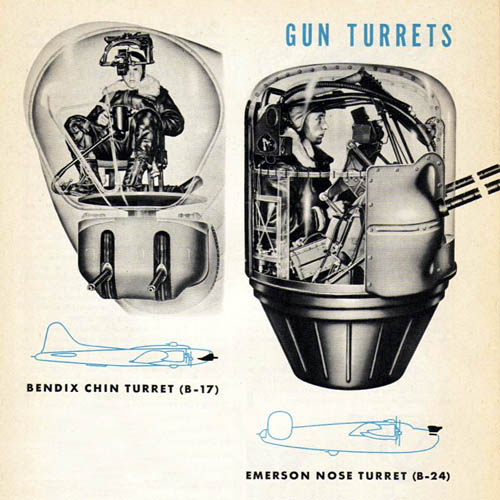From Bombardiers’ Information File, War Department, March 1945:
The bombardier is concerned primarily with those gun turrets he is most likely to operate. He is almost always responsible for control of the nose turrets in heavy and very heavy aircraft.
BENDIX CHIN TURRET (B-17)
The chin turret of the B-17 operates electrically by remote control from the bombardier’s seat directly above it. It moves 86° to either side in azimuth, 26° above and 46° below horizontal in elevation. It uses the N-8 or N-6A optical gunsight. The bombardier’s seat remains stationary; as he turns the gunsight, the guns swing around beneath. The bombardier’s control unit, housing the gunsight, pivots out from its stowed position on his right and locks in place in front of him.
EMERSON NOSE TURRET (B-24)
The nose turret of the B-24 is an all-electric turret which uses the N-8 or N-6A optical gunsight. It moves in azimuth about 75° either side of the airplane’s center line, and in elevation from 50° below horizontal to 60° above. It has 2 speeds, normal tracking and high. It contains armor plate, and bulletproof glass plate which moves with the guns.











There’s a really good article on aircraft gun turrets and gunners over here: http://bayourenaissanceman.blogspot.com/2008/07/weekend-wings-25-air-gunners.html
We had a B-17 at our airport a couple of years back, and they weren’t kidding about the Sperry ball turret being tiny.
Back in 1975, the museum at Lackland AFB in Texas had a Emerson nose turret off of a B-24 on display that incorporated a radar dome in its front for targeting enemy aircraft at night or in clouds. The interior of the turret was so packed with equipment that it was amazing they could actually fit a gunner in there.